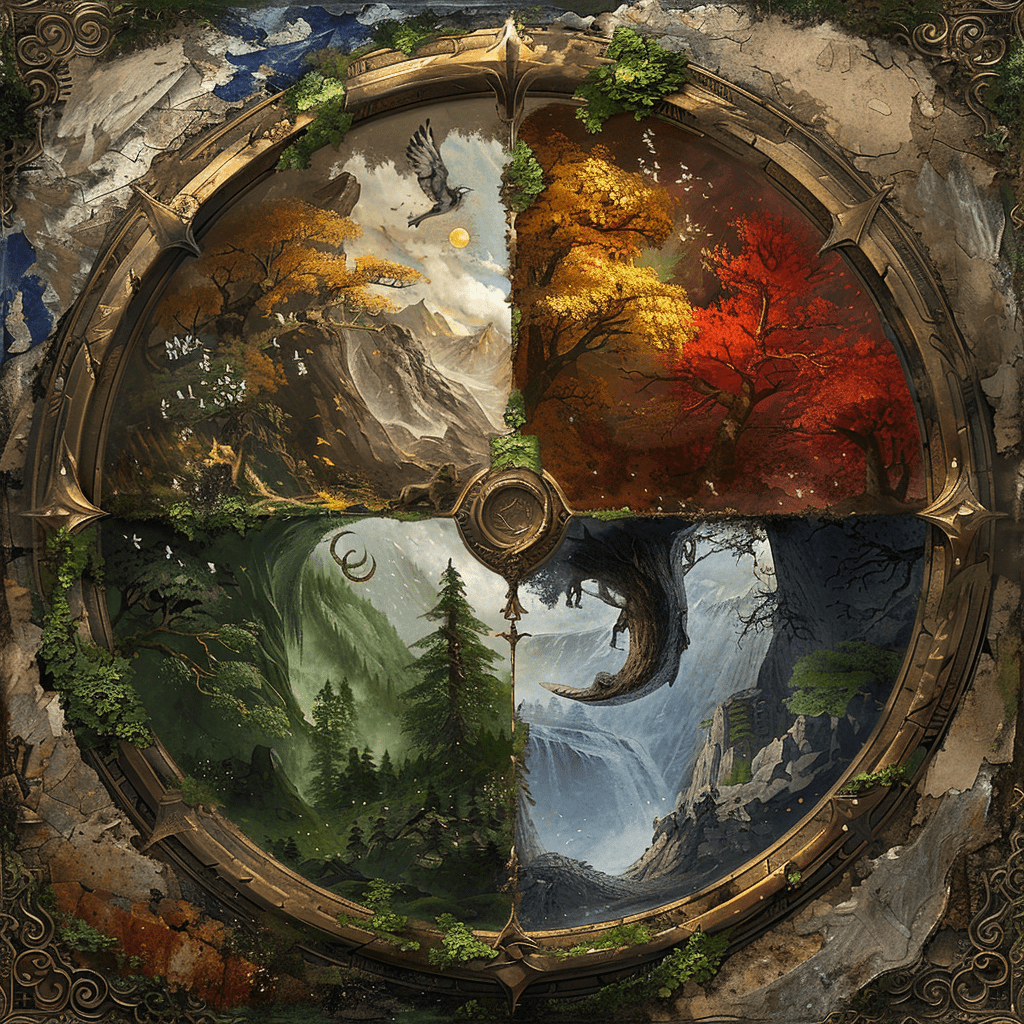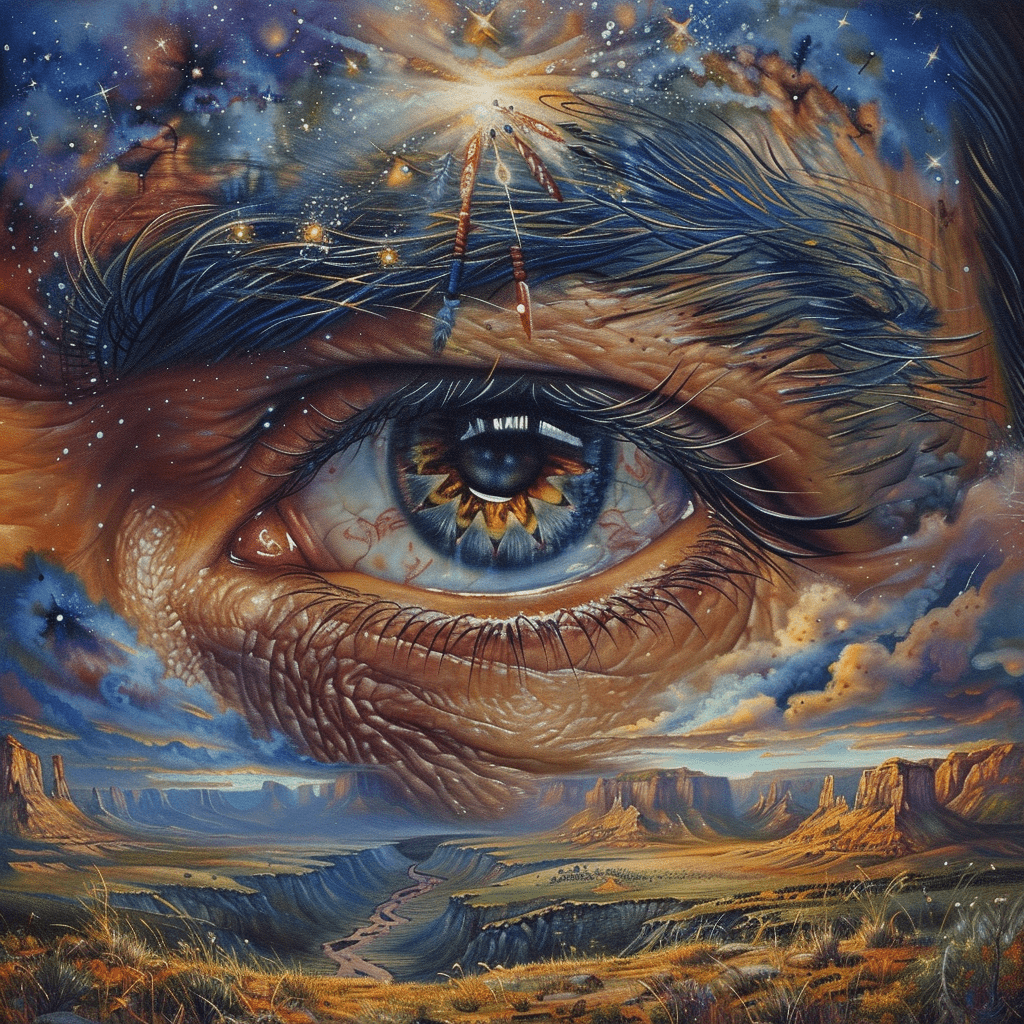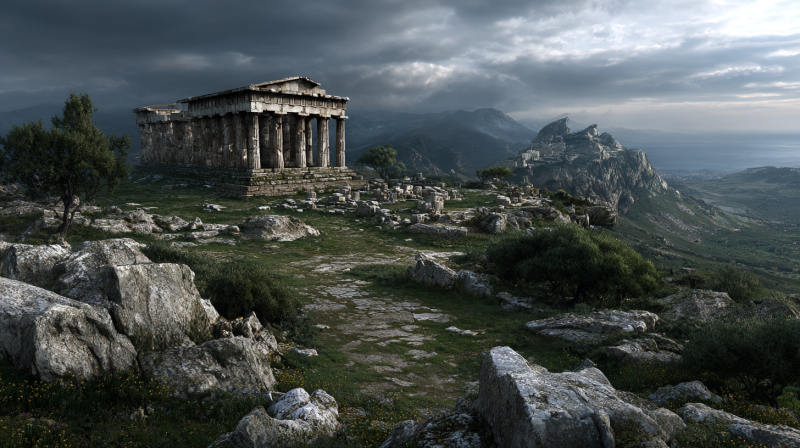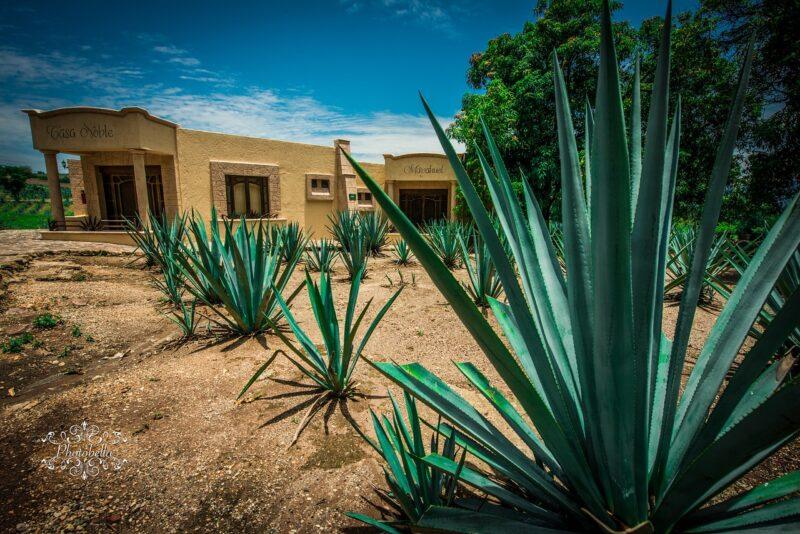In the heart of the North American landscape, scattered across the plains and nestled in the hills, ancient symbols etched into the earth whisper tales of spirituality, healing, and cosmic balance. These symbols, known as medicine wheels, hold profound significance in Indigenous cultures. They are not merely relics of the past but living testaments to a worldview steeped in harmony, respect, and interconnectedness. This blog post delves deep into the essence of medicine wheels, unraveling their mysteries, exploring their historical contexts, and celebrating their enduring relevance in Indigenous mythology.
The Origins of Medicine Wheels
Medicine wheels are circular arrangements of stones, often large and meticulously placed, found predominantly in North America, particularly in the Great Plains region. Their origins trace back to ancient times, with some estimates suggesting they were constructed as early as 4,500 years ago. The term “medicine wheel” itself is a modern one, coined by European settlers who observed these sacred sites. To Indigenous peoples, these wheels are known by various names, each reflecting their unique cultural interpretations and purposes.
The term “medicine” in this context is multifaceted. It does not solely refer to physical healing but encompasses a broader spiritual, emotional, and communal wellness. The wheel, a universal symbol of unity and cycles, further amplifies this holistic approach, embodying the cyclical nature of life, seasons, and the cosmos.
Structure and Symbolism
A typical medicine wheel comprises a central stone, or cairn, surrounded by an outer ring of stones. Spokes, often in multiples of four, extend from the center to the outer ring, dividing the circle into segments. Each element of the wheel is laden with symbolism, reflecting the profound connection between the earthly and the spiritual realms.
- The Center: Representing the core of existence, the central stone is the focal point where the physical and spiritual converge. It symbolizes the Great Spirit, the Creator, or the cosmic axis around which life revolves.
- The Outer Circle: Encapsulating the whole, the outer ring denotes the boundary of the physical world and the universe. It signifies wholeness, protection, and the cyclical nature of life and death.
- The Spokes: Typically numbering four, the spokes represent the cardinal directions—north, south, east, and west. Each direction carries distinct attributes and lessons, tied to various elements, seasons, and stages of life.
The Four Directions: Guardians of the Medicine Wheel
In Indigenous belief systems, the four cardinal directions are more than mere compass points. They are sacred beings or guardians, each with unique qualities and teachings.
NORTH
North stands for wisdom, endurance, and purity, embodying the stillness of winter. It is connected to the element of earth and the color white. The buffalo, symbolizing abundance and sustenance, is often the guardian of the North, teaching lessons of perseverance and gratitude.
EAST
The direction of the rising sun, East symbolizes new beginnings, illumination, and spiritual awakening. It is associated with spring, the element of air, and the color yellow. Animals like the eagle, revered for its far-reaching vision and connection to the sky, often represent this direction.
SOUTH
South is the realm of growth, warmth, and vitality, embodying the energy of summer. It is linked to the element of fire and the color red. The coyote or wolf, creatures of instinct and survival, symbolize this direction, teaching lessons of adaptability and inner strength.
WEST
As the sun sets, West signifies introspection, transformation, and the harvest. It is associated with autumn, the element of water, and the color black. The bear, known for its hibernation and introspective nature, represents the West, guiding individuals through personal journeys of self-discovery and healing.
Stories and Legends: The Medicine Wheel in Indigenous Narratives
Storytelling is a cornerstone of Indigenous cultures, a means of preserving history, imparting wisdom, and fostering community bonds. Medicine wheels frequently feature in these narratives, serving as both literal and metaphorical devices.

The Tale of the Four Winds
One such story tells of the Four Winds, powerful spirits residing in each cardinal direction. These Winds governed the elements and seasons, bringing balance to the world. However, their differing temperaments often led to discord. The East Wind, with its gentle breezes, clashed with the fierce gusts of the West Wind. The fiery South Wind’s warmth was at odds with the cold North Wind.
In the heart of their quarrel, the Great Spirit created the medicine wheel, instructing the Winds to anchor themselves to its spokes. This sacred circle harmonized their energies, teaching them to work in unison. Through this tale, the medicine wheel became a symbol of balance, teaching the importance of unity and cooperation.
The Vision Quest
A vision quest, a rite of passage for many Indigenous youths, often involves the medicine wheel. Young seekers venture into the wilderness to fast and pray, seeking visions or messages from the spirit world. They create a small medicine wheel, aligning themselves with the cardinal directions and their spiritual attributes.
One such legend speaks of a young boy named Takoda, who embarked on his vision quest during a time of personal turmoil. Within the confines of his medicine wheel, Takoda encountered spirit animals and ancestral guides who imparted wisdom and strength. The vision quest, centered around the medicine wheel, symbolizes the journey towards self-discovery and spiritual enlightenment.

The Medicine Wheel as a Healing Tool
In addition to its symbolic and mythological significance, the medicine wheel serves as a powerful tool for healing and meditation. Indigenous healers, or medicine men and women, utilize the wheel in various ceremonies and rituals designed to restore balance and harmony within individuals and communities.
The Healing Circle
A traditional healing circle involves participants sitting around a medicine wheel, often constructed on the ground or represented by an arrangement of objects. Each person speaks in turn, sharing their experiences and emotions. A healer leads the circle, which offers a secure setting for expression and group healing.
One profound example is the story of a community struck by a devastating illness. The healer, sensing the need for collective recovery, organized a healing circle around a medicine wheel. Through shared stories, prayers, and songs, the community drew strength from the wheel’s energy, finding solace and healing in their unity.
Plant Medicine and the Medicine Wheel
The medicine wheel also serves as a guide for the use of plant medicines. Indigenous healers often align various herbs and plants with the directions and their corresponding elements. For instance, sage, associated with purification and the element of air, is linked to the East. Cedar, with its protective qualities and connection to earth, is aligned with the North.
In healing ceremonies, these plants are used in conjunction with the medicine wheel to create a holistic approach to wellness. The interplay of physical remedies and spiritual practices embodies the comprehensive nature of Indigenous medicine.
The Contemporary Relevance of Medicine Wheels
In modern times, the medicine wheel remains a vital part of Indigenous culture, evolving to address contemporary issues while preserving its ancient wisdom. It serves as a symbol of resilience, cultural identity, and environmental stewardship.
Education and Cultural Preservation
Many Indigenous communities and educational programs incorporate the medicine wheel into their curricula to teach young generations about their heritage. This educational approach fosters a deep understanding of cultural values, environmental awareness, and spiritual practices.
In schools and cultural centers, the medicine wheel becomes a focal point for learning and reflection. Students engage in activities that honor the wheel’s teachings, such as storytelling, art projects, and environmental stewardship initiatives.
Environmental Stewardship
The medicine wheel’s emphasis on balance and interconnectedness resonates deeply with modern environmental movements. Indigenous communities advocate for sustainable practices, drawing on the wheel’s principles to promote harmony with nature.
One notable example is the fight against climate change. Indigenous leaders often invoke the medicine wheel’s teachings to emphasize the importance of respecting natural cycles and protecting the earth’s resources. This perspective fosters a holistic approach to environmental conservation, advocating for policies that honor both human and ecological well-being.
Healing and Mental Health
The medicine wheel’s holistic approach to healing has found a place in contemporary mental health practices. Therapists and counselors, particularly those working with Indigenous populations, integrate the wheel’s principles into their therapeutic approaches.
For instance, the medicine wheel’s focus on balance and harmony can be applied to mental health, addressing emotional, spiritual, physical, and mental well-being. This comprehensive approach resonates with individuals seeking a more inclusive and culturally sensitive form of therapy.
Personal Reflections and Connection
For those outside Indigenous cultures, the medicine wheel offers profound insights and lessons applicable to everyday life. Its teachings on balance, interconnectedness, and respect for all beings can inspire personal growth and spiritual exploration.
Creating Your Own Medicine Wheel
Constructing a personal medicine wheel can be a meaningful way to connect with these teachings. Begin by choosing a quiet, natural location, and gather stones or objects to represent the wheel’s elements. Reflect on each direction’s attributes, considering how they apply to your life.
As you arrange the stones, meditate on the balance and harmony within the wheel. This practice can foster a sense of peace and connectedness, serving as a daily reminder of the lessons the wheel imparts.
Integrating the Wheel’s Teachings
Incorporate the medicine wheel’s principles into your daily routines. Reflect on the cyclical nature of life, honoring the transitions and transformations that occur. Embrace the teachings of the four directions, seeking balance in your actions, thoughts, and relationships.
By integrating these teachings, you can cultivate a deeper appreciation for the interconnectedness of all things and foster a sense of harmony within yourself and the world around you.
The Enduring Legacy of Medicine Wheels
The medicine wheel stands as a testament to the rich spiritual heritage of Indigenous cultures, embodying timeless wisdom and profound teachings. Its symbolism, stories, and healing practices offer a holistic approach to life, emphasizing balance, interconnectedness, and respect for all beings.
In contemporary times, the medicine wheel continues to inspire and guide, serving as a bridge between ancient traditions and modern challenges. Whether through education, environmental stewardship, or personal reflection, the wheel’s teachings remain relevant and transformative.
As we honor the sacred circle, we recognize the enduring legacy of Indigenous wisdom and the vital lessons it imparts. The medicine wheel, with its profound symbolism and holistic teachings, invites us to embrace a path of balance, harmony, and interconnectedness, fostering a deeper connection with ourselves, each other, and the natural world.
References
- Kehoe, Alice B. “The Medicine Wheel: Ethnohistorical Contexts and Cultural Significance.” Plains Anthropologist, vol. 25, no. 90, 1980, pp. 113-129.
- Bastien, Betty. Blackfoot Ways of Knowing: The Worldview of the Siksikaitsitapi. University of Calgary Press, 2004.
- Storm, Hyemeyohsts. Seven Arrows. Harper & Row, 1972.
- Lame Deer, John (Fire) and Richard Erdoes. Lame Deer, Seeker of Visions. Simon and Schuster, 1972.
- Cajete, Gregory. Native Science: Natural Laws of Interdependence. Clear Light Publishers, 2000.
- Ross, Rupert. Returning to the Teachings: Exploring Aboriginal Justice. Penguin Books, 1996.




